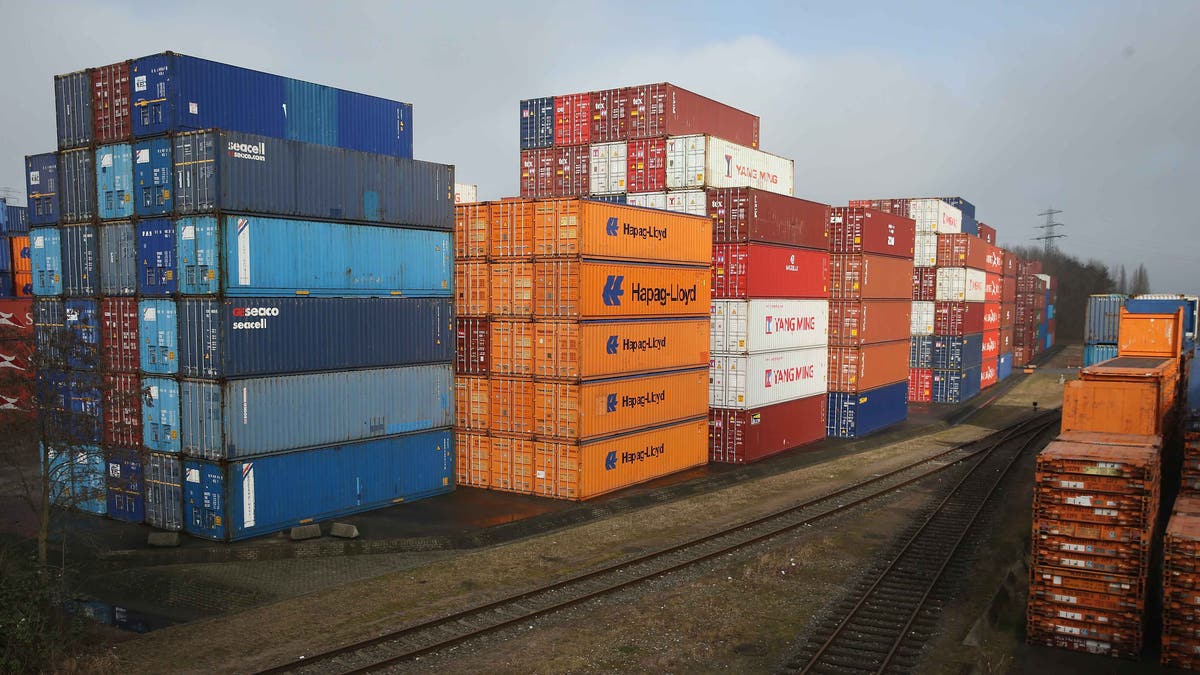
HAMBURG, GERMANY - MARCH 04: Stacked shipping containers stand next to railway lines at a terminal at Hamburg Port on March 4, 2016 in Hamburg, Germany. According to the most recent data Germany has the highest trade surplus in the world, at EUR 285 billion for 2014. Its major exports include cars and other vehicles, as well as machinery, chemicals and pharmaceuticals. (Photo by Sean Gallup/Getty Images) (2016 Getty Images)
In the rhetoric-laden 2016 presidential race, the North American Free Trade Agreement (NAFTA) has been characterized as a detriment to the American worker and the U.S. economy. The agreement between the United States, Canada and Mexico that eliminates most tariffs on trade was intended to provide an economic benefit.
So has it?
Republican nominee Donald Trump, former Democratic candidate Sen. Bernie Sanders and other politicos don’t think so. But much of their NAFTA-bashing hyperbole has been overly simplistic and light on specifics. Here are some facts about this 20-year-old trade deal.
1. NAFTA has yielded a net benefit to the U.S. economy.
While the United States has experienced a net loss of 15,000 jobs per year because of the trade agreement, according to the Peterson Institute for International Economics, higher productivity and lower prices have generated about $450,000 for each job lost. And despite the modest job losses, the U.S. Chamber of Commerce estimates that trade with Canada and Mexico still supports 14 million American jobs, 5 million of which are a result of NAFTA. The agreement’s positive effects have been more prominent in some states and regions. In Texas, for example, there was a six-fold increase in exports to Mexico between 2004 and 2015 (NAFTA was fully implemented in 2008), and more than one million Texans work in the state’s export industry.
2. Many economic and industry trends attributed to NAFTA arose before the trade agreement and would have continued without it. There was a surge in Japanese imports in the 1980s, which impacted the Rust Belt states, depressing the steel and automotive industries. Between 1976 and 1990, for example, the share of Pittsburg workers in manufacturing fell from 35% to 17%. Meanwhile, the rapid expansion of Chinese manufacturing took a heavy toll on U.S. manufacturing.
While the auto industry in the north (notably in Detroit) has been decimated, it is in part because manufacturers moved into southern states where there are fewer unions, a trend that began in the 1950s. At the same time, facing increasing foreign competition and a need for lower operating costs, there has been a steady increase in robotics across the manufacturing industry. This has erased the need for low-skilled labor and created a new need for a skilled labor force that can build and operate advanced machines and robotics. Currently, there are 5.4 million unfilled jobs in the United States owing largely to an absence of high-skilled American workers. For job hunters and presidential candidates, Americans need to learn a trade, not blame free trade.
3. NAFTA allows American companies to more economically produce goods, increasing prosperity and job creation. Manufacturing is not a one-way street; often, goods produced by U.S. companies and sold abroad cross North American borders multiple times before they are ready for market. That creates economic activity and jobs in commercial logistics and more vibrant manufacturing sectors. Indeed, about 40% of the materials used to make Mexican exports are originally produced in the United States and sold tariff-free by U.S. companies.
Some jobs have been relocated to Mexico, true, but U.S. businesses have been smart to take advantage of the absurdly low labor costs across the border. While Democratic candidate Hillary Clinton touts raising the federal minimum wage to $15 per hour, the minimum wage in Mexico is $4 per day. The enormous cost savings found in accessing this cheap labor force gives U.S. companies a significant competitive advantage in the global marketplace, allowing them to sell at lower prices, outcompete businesses in other nations, and in turn raise the U.S. GDP. This is particularly important because at 35%, the United States holds the highest corporate tax rate in the world, making U.S. companies decidedly noncompetitive globally.
4. Pulling out of NAFTA would have real consequences for American consumers and the U.S. economy. Closing off trade dramatically reduces purchasing power for middle- and lower-income Americans. This is because higher tariffs lead to higher business costs that are passed on to the consumer in the form of higher prices. Taking the United States out of NAFTA would also hurt U.S. businesses, in turn decreasing job creation. Mexico is the number one trading partner for nearly two dozen states in the Union.
A denim manufacturing plant in Mauldin, SC, for example, exports 85% of its product to Mexico, where it is turned into jeans. Adding tariffs would increase the cost of denim, pushing Mexican manufacturers to source their materials from cheaper suppliers in other countries and hurt the American business in the process. This scenario holds true for many U.S. industries. As former Mexican president Vicente Fox told CNN, “There are a lot of great friends around the world…where Mexico can do business. If [the] United States would not like to do business with Mexico, we can do it somewhere else.”
Perhaps the most important point about NAFTA is that free trade is enormously complex with many factors at play, all of which make it difficult to precisely measure cost and benefit. To be sure, however, that complexity cannot be expressed in angry talking points, and this important subject should be treated with the intelligence and sophistication it deserves.
